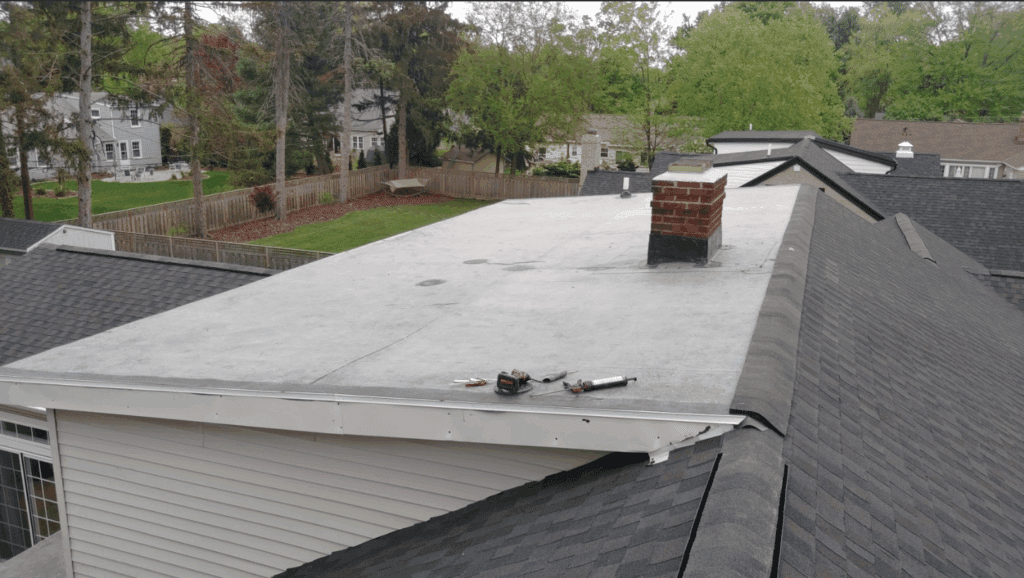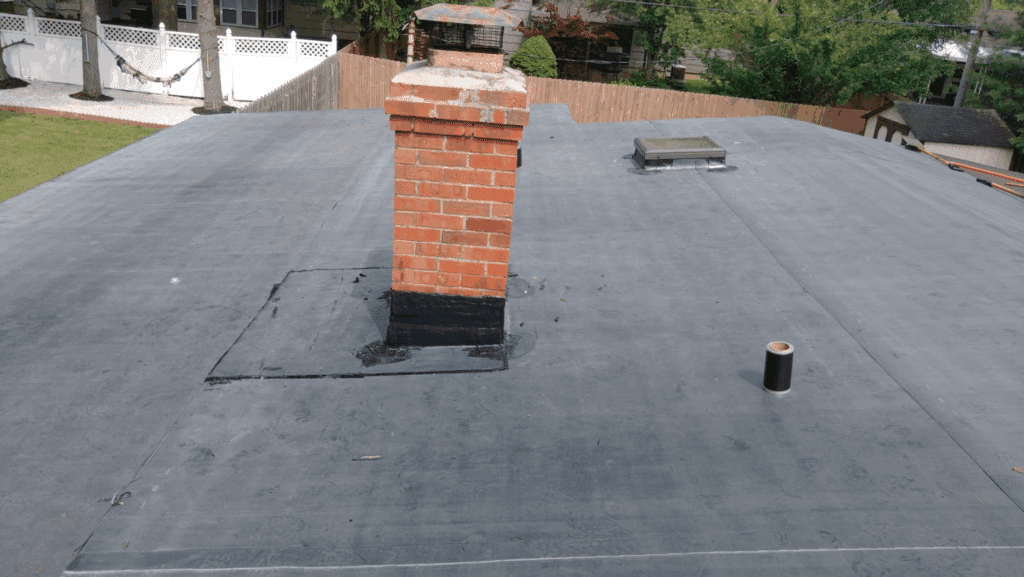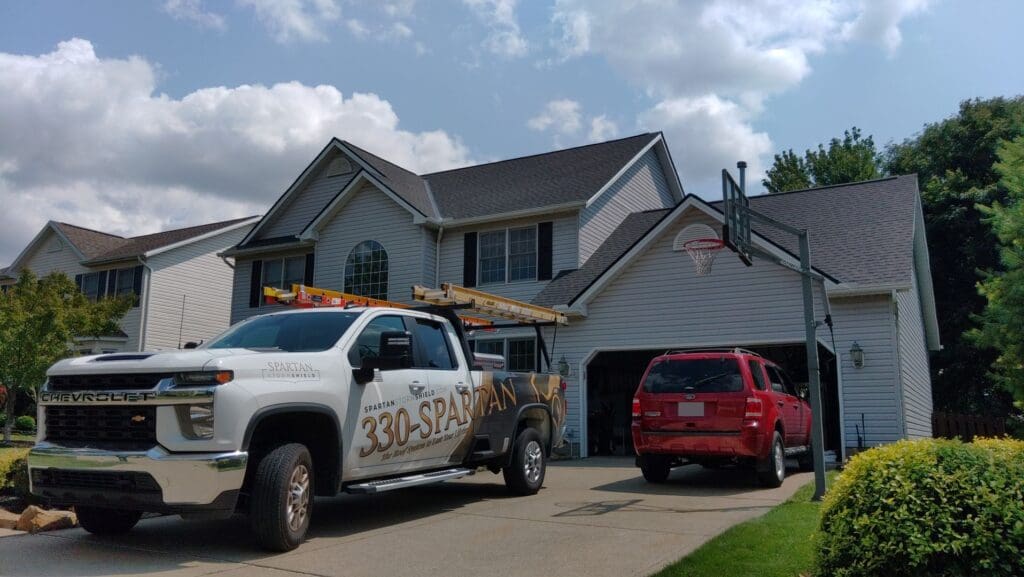
Low-Slope Roofing Experts in Ohio
Low Slope Roofing Services
At Spartan StormShield, we offer expert installation, repair, and replacement of low slope roofing systems for homes and buildings throughout Ohio. Whether you’re managing a flat-roofed addition, garage, or entire structure, our team delivers solutions built for durability, weather resistance, and long-term performance in Ohio’s tough climate.

Let's Get You Free Pricing



What Is a Low Slope Roof?
A low slope roof is a roofing system with a pitch of less than 3:12 (meaning the roof rises less than 3 inches for every 12 inches of horizontal run). These systems are engineered to shed water slowly rather than relying on rapid runoff, which requires specialized design considerations for waterproofing and drainage.
Unlike steep-slope roofs that use overlapping shingles to deflect water, low slope roofs depend on continuous membrane systems—such as modified bitumen, EPDM, TPO, or PVC—to create a watertight barrier. Proper installation includes:
-
Minimal Positive Slope – Even “flat” roofs have a slight incline (typically between ¼” and ½” per foot) to promote drainage toward scuppers, drains, or gutters.
-
Substrate Preparation – Roof decks must be level, stable, and capable of supporting the membrane without sagging, as ponding water can accelerate deterioration.
-
Layered System Design – Often includes a vapor barrier, insulation, cover board, and single-ply or built-up roofing membrane.
-
Flashing Integration – Critical at penetrations, edges, and transitions to prevent water ingress.
Low slope roofs are common in commercial and industrial applications but are also used in residential construction for porches, garages, additions, and modern architectural designs. Their performance depends heavily on precision installation, material quality, and ongoing maintenance.


Our Low Slope Roofing Services
Installation
We install high-performance low slope roofing systems for both new construction and property upgrades. Our team ensures proper slope design, waterproofing, and drainage so your roof performs in every season.
Repair
Flat roofs are vulnerable to ponding water, cracks, seam separation, and general wear. Our repair services address leaks, membrane damage, and flashing failures, extending the life of your roof and preventing costly interior damage.
Replacement
When your low slope roof has reached the end of its life, we provide full removal and replacement. We inspect the deck, resolve any structural issues, and install a new system to meet Ohio’s building codes and weather demands.

Our Roofing Process
- Inspection & Consultation – We assess your roof’s condition and identify your best options.
- Estimate & Material Planning – You receive a detailed estimate and timeline for the work.
- Scheduling & Prep – We protect your home and prepare the site for clean, safe execution.
- Installation or Repair – Our trained crews complete the job with precision and care.
- Final Walkthrough & Warranty – We ensure your satisfaction and deliver warranty documentation.
Who Has a Low-Slope Roof & Why Choose One?
Low-slope roofs are common on a wide range of residential and commercial properties. You’ll often find them on:
-
Modern Homes & Additions – Many contemporary architectural styles favor clean lines and minimal roof pitch for a sleek, modern appearance.
-
Garages & Porches – Low slope roofs provide functional coverage with an efficient design.
-
Multi-Family Buildings – Apartments, townhomes, and condos often use low slope roofing to maximize interior space and simplify maintenance.
-
Commercial & Industrial Buildings – Warehouses, retail stores, and office complexes frequently use low slope systems for cost-effective coverage over large areas.
Why choose a low slope roof?
-
Cost-Effective Construction – Requires fewer materials and less labor than steep slope designs.
-
Easier Maintenance & Access – Safer and simpler to inspect, clean, and repair.
-
Space Efficiency – Can allow for HVAC placement, solar panels, or even rooftop gardens in some cases.
-
Modern Aesthetic – Complements contemporary designs and adds architectural versatility.
-
Durability in the Right Hands – When properly installed and maintained, a low slope roof can last decades and withstand Ohio’s challenging weather.
FAQs About Low-Slope and Flat Roofing
A low slope roof is defined as any roofing surface with a pitch of less than 3:12, meaning it rises fewer than 3 inches vertically for every 12 inches of horizontal run. While they often appear flat to the naked eye, they are carefully engineered with a subtle slope—usually between ¼ inch and ½ inch per foot—to allow for proper drainage. These roofs require specialized waterproofing membranes, drainage systems, and flashing details to handle water management effectively, since gravity alone moves water more slowly compared to steep-slope designs.
Yes—provided they are installed and maintained correctly. Ohio’s climate brings a mix of heavy rain, snow, freeze-thaw cycles, and hot summers, all of which place unique stress on roofing systems. A well-built low slope roof uses durable, weather-resistant materials such as EPDM, TPO, or modified bitumen, paired with proper insulation and drainage design. Adequate sealing and flashing are essential to prevent leaks during snowmelt and spring rains. With these measures in place, a low slope roof can perform reliably year-round in Ohio’s challenging conditions.
Most low slope roofing systems last between 20–30 years, though lifespan depends heavily on the material type, installation quality, and ongoing maintenance. For example, EPDM can often last over 25 years with regular inspections and timely repairs, while TPO and PVC systems can provide similar longevity if seams and flashings remain intact. Neglecting maintenance—such as failing to address small leaks, clear debris from drains, or repair membrane punctures—can significantly shorten a roof’s service life.
You should consider replacement when you notice signs of advanced wear or failure, such as:
-
Persistent or recurring leaks despite multiple repairs
-
Standing water that does not drain within 48 hours after rainfall
-
Membrane blistering, cracking, or shrinkage that exposes seams or flashing
-
Seam separation or lifting edges that compromise the watertight seal
-
Visible structural issues such as sagging roof areas or rotting deck material
Delaying replacement after these signs appear can lead to costly interior damage, mold growth, and even structural compromise. A professional inspection can confirm whether targeted repairs or a full roof replacement is the best course of action.
Why Choose Spartan StormShield?
As a locally owned and operated roofing contractor, Spartan StormShield brings more than a decade of low slope roofing experience to every project. Our team is fully licensed and insured, trained in the latest low slope techniques, and committed to doing the job right the first time. We stand behind our work with strong warranties and a customer-first approach.
Areas We Serve
We proudly serve communities throughout central and northeastern Ohio, including Columbus, Cleveland, Akron, Canton, and nearby towns. Not sure if you’re in our service area? Contact us today to find out.
Serving Northeast and Central Ohio
Spartan StormShield is proud to provide roofing services to Cleveland, Akron, Columbus and all surrounding areas.



